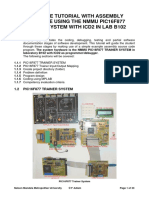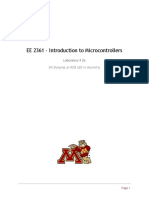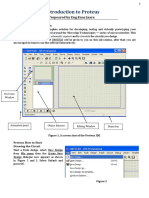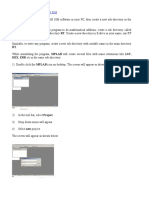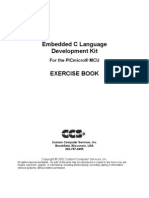0 ratings0% found this document useful (0 votes) 75 views17 pagesDEC40053 Embedded System Application
Copyright
© © All Rights Reserved
We take content rights seriously. If you suspect this is your content,
claim it here.
Available Formats
Download as PDF or read online on Scribd
POUT SHnilx
MALAYSIA'
ELECTRICAL ENGINEERING DEPARTMENT
ACADEMIC SESSION:
DEC40053 - EMBEDDED SYSTEM APPLICATIONS
PRACTICAL WORK 1: INTRODUCTION TO MPLABX AND
CIRCUIT SIMULATION
PRACTICAL WORK DATE :
LECTURER’S NAME:
GROUP NO. :
TOTAL
STUDENT ID & NAME : MARKS,
(100%)
a
8
@
()
DATE SUBMIT : DATE RETURN :�LEARNING OUTCOMES (LO)
1. Construct and sinmulate real-time embedded system application based on PICI6F/PICI8F
microcontroller effectively
OBJECTIVE
1. Write program in C language in MPLABX.
2. Draw and simulate PIC circuit in Proteus.
3. Build output hardware circuit using LEDs
THEORY
A) MPLAB
MPLAB X Integrated Development Environment (IDE) is an expandable, highly configurable software
program that incorporates powerful tools to help you discover, configure, develop, debug and qualify
embedded designs for most of Microchip’s microcontrollers and digital signal controllers. MPLAB X
IDE works seamlessly with the MPLAB development ecosystem of software and tools, many of which
are completely free
B) PROTEUS
Proteus is a design software developed by Labcenter Electronics for electronic circuit simulation,
schematic capture and PCB design. Its simplicity and user friendly design made it popular among
electronics hobbyists. Proteus is commonly used for digital simulations such as microcontrollers and
microprocessors. It can simulate LED, LDR, USB Communication and many more.
EQUIPMENT / TOOLS
1. Personal Computer (PC)
2. MPLAB IDE software
3. Proteus software
PROCEDURE
At desktop, create a folder named P1. In the P1 folder, create subfolder as below.
4 (> et
a Quick access
Box Sync
I Desktop
Documents
} Downloads
circurt REFERENCE
see�Open MPLAB X. Click File>New Project or New Project icon.
File Edit View Navigate Source Refactor Production
F) New File. CteleN
GF openroject.. Cte shiteo
Open Recent Projac
Import >
Ea
File Edit View Navigate Source Refactor Production
AGgS Se
‘Step I>Choose Project. Select Microchip Embedded option in Categories and Standalone Project in
Projects. Click Next
(Brent Pex omit eget
1B vee naan moet,
1B treyromt
Bingen res rect
1B inert tte aco rom
[cestes nen score scat conc. Russ DE greeted bila�Step 2>Select device. Select All Families in Family option. In device option, select suitable PICISE
microcontroller (PIC18F45K22). Click Next.
i
2] ES ey [ea] [ee
New>main.c
Ears
File Edit View Navigate Source Refactor Production Debug Team Tools Window Help
BES OG be AT -B > EE
wee
=
ult
Projects x) Files | Classes Gi|{ StatPave
New Logical Folder B csource File. 4
Ad xing Rem Gimme
Add Existing Items from Folders... Bl xc header.
Find. B owmaine i
3.11 | At file name, type LED. In extension, option c is default selection. Ignore other option,
‘casted C/UsevES AiG DedioePIPWLUED.C
ea] SS Ce] oe)
Bz | A file named LED will appear below Source Files.
(Projects x] Files | Classes
o@ pm�313
‘A window named LED. will appear as below. This is where you will write your source code.
Seaeoe = 53.22 Oise eee
[asm enter an 4
[See alasrsiveciadeuaae !
ue 1
' '
' '
ML ,
Check seiting for your compiler. Click Project Properties at dashboard or click File>Project
Properties>XC8 Global option. At C Standard, select C90.
[BB new Pj. conesniten
a as ape nm
1 ae
a= sp mt nn
Fea
= . fess
a BU YF Settnge ne rereaeencon
cm Pees
Sear 1 8 Sise sonore
hoe Pees a
omme =
a ; =e
Grea tirapat nner
re sess
Pej Prparie PW)
sects�3.15 | Copy and paste program given in Appendix A into your coding window. Modify the void main (void)
block with the source code below.
void main (void)
{
setup();
Ising t ddr >1
TRISBbits.TRISBO
while (1) Loox ver
{
LATBbits . LATBO=.
}
}
File Edit View Navigate Source Refactor Production Debug Team Tools Window Help
ASS |} © (co iinaainrget
BH Clean and Build Main Project. Shift+F11
Batch Build Main Project...
Set Project Configuration >
Set Main Project >
‘Set Configuration Bits
Check File AlteF9
Validate File Alte Shift+F9
ado
Repeat Build/Run Cte FIT
Stop Build/Run
Tao tn Hop
i ee
[Build Main Project FT) |p�{If your program has no error, you will get BUILD SUCCESSFUL statement in output window as
below. If your program has error, you will get BUILD FAILED statement. Double click the error
message and fix your program,
1D simulator = Trace/Proting PW (ul ond) =
[BUILD SUCCESSFUL (eotal time: 122)
Loading code trom ¢:/Users/E5-4715/Deskep/D1/PUL.X/dist/detasic/prodsction/FWL.x. production hex.
8.18 | Double click Proteus 8 Professional icon, Then click ISIS icon as Figure 18.
SD: as EE
a
(o¢a9 deb ae
hea
* PROTEUS DESIGN SUITE 8.0
5.19
Untitled Proteus 8 Professional-Schematic Capture work area will appear as below. Select button P or
Pick parts from libraries icon.
3 LWTTED rie 8 Peon Shana Cp ay
Tie Cat Wow Too! Dagh Gaph eh Uy Tenlae Spon tip :
| O6B9 Gmmasmo= (0 BR\++4909 Oe KOS Semm ae
{ HonePage (El Schematic Captre x
m
Benet e�10. | Pick Device window will appear. This is where you can select your components for simulation. You
can type the components name in Keywords box or you can select in Category option,
Double click your left mouse to select components below:
© Microprocessor ICs > PICISF Family > PICI8F45K22
* Resistors > 0.6W Metal film > MINRES330R
© Optoelectronics > LEDs > LED-RED
»
>)
+
e
a
(@@_cevces
LED-RED
MINRES2208
[aBESZ
oe +
‘When all components are selected, click Cancel button to go back to ISIS window.�Save this circuit as LAB.
PICTEFIORDD
U1
RAOIC12INO/ANO
RAWICI2INIIANI
RAZIC2INW/AN2;DACOUTVREF-
RAQICIINWANSVREF+
RAAICIOUTISRTOGK!
RASIC2OUTISRNQ'SST/HLVDINANS
RABICLKOIOSC2
RATICLKUIOSC1
RBOIINTOFFLTO'SRVANI2
RBY/INTUCI2INS/ANTO
RBZIINT2/CTEDI/ANS.
RB3ICTEDUP2A/CCP2ICI2IN2/ANO
RBAIOCOTSGIANTT
RBSIOCTPSAICCP3TSCKUTIGIANTS
RBBIOCAPGC
RB7/IOCSPGD
2/9) we
aa t
He
2)? Seam
on DEFAULT
2. iter &
fjSyt [por Oo
' as
~D Terminals Mode @
wrt 4
i
'
Construct circuit shown in Figure 23. To set power and ground source, select Terminal Mode > Power
and Ground. Click Instruments icon and select DC Voltmeter.
ROUP2BITSCKUT3GITICKUSOSCO
RC1/P2AICCP2/SOSCI
ROZICTPLSIP1AICCPITSCKLAN'4
RCSISCKSCLIANIS
RCAISDIVISOAWAN1S,
ROSISDOWANI7
ROBTXY/CKVANTS
RCTIRXUDTHVANI9
RDOISCK2/SCL2/AN20
RDIVCCP4/SDI2/SDAZIAN21
RD2P2BIAN22
ROBPZGSSIANZS
RDAIP2D/SDO2/AN24
ROSP1BIAN25
RDGIP1C/TX2ICKZIANZS
RD7IPID/RX2DT2IANQT
REOPSAICCPSIANS
REWP3BIANG
REZICOPSIANT
NCTRVPPIRES
INSTRUMENTS
OSCILLOSCOPE
LOGIC ANALYSER
COUNTER TIMER
VIRTUAL TERMINAL
SPI DEBUGGER.
2c DEBUGGER
SIGNAL GENERATOR
PATTERN GENERATO|
DC AMMETER,
AC VOLTMETER
JAC AMMETER,
To save your circuit, select File > Save Project As. Go to Desktop » Pl Folder > CIRCUIT sub folder.�Double click your PICISF45K22. Edit component window will appear as below. At Processor Clock
Frequency, set 64MEIZ.
Past Reference: ut Hiddere [] OK ]
Pat abe CuaFaska2 Hide: C1 | ap
Element: New Daa
ce Package: ila Hider) | | Hidden Pie
ProgenFie, LG Heat S| Fete
eaMH2 Hide aly
1) Processor Clock Frequency a
‘Advanced Properties:
Force ADC Breakpoint At Sample Time? | (Defaut) ©) Hide Aly
Other Properties:
(Exclude from Simulation DAtach hierarchy module
(DE molude from PCB Layout Hide common pins
(CE welude from Bil of Materials COE Git al properties as text
Load the hex file into Proteus. In MPLAB X, at the output window, copy the statement below and
paste in program file in Proteus.
Outut =
WD Simatator = Trace/Profing = PW (Build, toad) x
sore svoceser (Ie TAZ, y
Lansing code 2=] €:/Usera/$5-4710/Deakop/PI/PAl_X/dtat/detasle/production/PH1 X production hed I
a Hier: C)
[riers die
New
iLan S| [Rite S
TE Aisonie5 471670 eshion? [Hide A v
Processor Clock Fiequeney aie Vie�To run your circuit, click Debug > Run Simulation or click the Run Simulation button at the bottom
left of your ISIS window. To stop simulation, click Stop The Simulation button,
[Beit] Ubon Template system Help
ID) stort si Debuaging caer
Run Simulation (timed breakpoint)
‘Write new programming to do task below. Right click Source File>New>main.c. In File Name
option, type LED2.
Stage tame and cation
3 Romeand ton Femeet [ese
rom: Pit
ee | Pere
ened le: Uses ies PAP HLL
Remove LED.c code from Source Files. Right click LED.c name below Source Files=Remove From
Project.
Popa rie dees =
ce te concn
Compt te
event
a" ,
wo 5
SE pepe:
pause�‘Make sure only LED2.¢ code remain below Source Files.
[Projects =| Files | Classes
G pw.
© GD) Header ries
@-(G Important Fes
@( Unker Fes
GB} Source Fes
Sma
(i Ubraries
(HP Loodables
5.26 | Write the source code below for LED2.< program,
void main (void)
{
setup()7
ir program
idx k
t
Por v
}
Build your LED2.¢ code
527
‘Draw cireuit for LED2.c program and simulate them in Proteus.�6 [Task
Build C program to perform task below. Design its circuit in Proteus. State your observations.
a) Make Port D produce SV. Use bit addressable instructions.
b) Make pin RB7, RBS, RB3 and RBI ON and other Port B pins OFF. Use byte addressable
instruction,
©) Make REO, RAI, RB2, RC3 and RD4 HIGH,
7 | RESULT
8 | DISCUSSION
9 | CONCLUSION�Appendix A
include
#define_XTAL_FREQ 640000001
void setup(void);
void delay(unsigned int x);
void main (void)
semup();
‘Your program start here
/Your program end here
BAHAGIAN INI JANGAN KACAU :)
void setup(void)
ANSELA = 0000000000;
200000000,
100000000:
‘ob00000000:
ANSELE = 0600000000;
VREFCONO = 0610110000; // Fixed Voltage Reference is enabled, x4 (4.096V)
ADCONI = 0600110000; (0001 10000=4.096V 0b00100000=2,048V 0'00000000=Vadd
ADCON? = 0610000011.
1x00;
1x00;
1x00;
LATD = 0x00;
LATE = 0x00,
void delay(unsigned int x)
for(:x>0;
|_delay_ms(1)
static void interrupt ISR(void)












